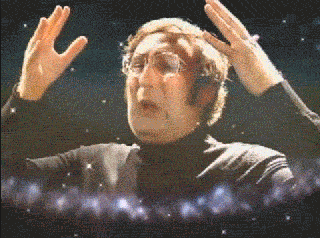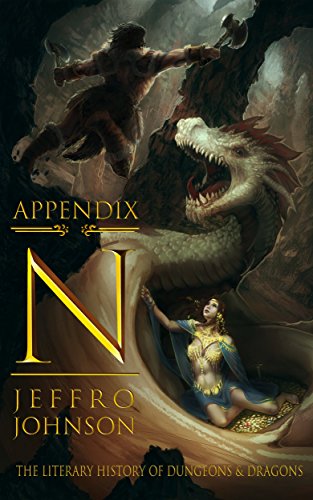 This recent conversation from Twitter is one I’ve seen play out many, many times:
This recent conversation from Twitter is one I’ve seen play out many, many times:
Sarah Edelweiss: Fire Emblem is making me want to reread The Lord of the Rings trilogy. TLotR was the grandfather of the RPG genre.
Kiefer: I like to think of it as the father of the entire modern fantasy genre in general! LotR–>DnD–>Warhamner/Warcraft–>Everything!
Appendix N Book Club: Interestingly Gary Gygax denies Tolkien was the main influence, quoting A. Merritt, Lovecraft, de Camp & Pratt, and Howard as main sources
Kiefer: Interesting? Do you think he denies it on purpose due to their chronological closeness or does his logic check out?
Appendix N Book Club: Some say he denies it due to Tolkien estate lawsuits. The D&D inspirations are clear for all of these authors though
Sarah Edelweiss: I could believe that’s it. Lawsuits or reputation tend to be the cause of denying influence.
You see it, don’t you? People begin with an uniformed view that seems plausible. Then they are shown claims made by Gygax that do not fit with it. Then… without considering any evidence whatsoever, they leap to the conclusion that Gary Gygax was a liar.
I can see why that might feel plausible. And I’m sure it’s nice having a convincing-sounding rationale that fits with your off the cuff reaction. But seriously… you can do better than that.
Of course, evidence alone can’t address this. People can go back and forth citing things Gygax said, things in the rules, and who did what and when for quite a while without coming to agreement. But I think the real issue is that people generally have no idea what D&D was like when it was first created. (They think about what it became in the eighties and later and extrapolate backwards from there, creating a made up origin story to go with it.) Further, they really have no concept of how fantasy and science fiction evolved during the twentieth century, so they bring all kinds of weird assumptions to the table when they try to imagine what it was like for the guys that created fantasy role-playing hobby.
Simply put, fantasy after about 1980 has very little in common with that which came before. And most people making generalizations about the genre have no concept of what things were like before Terry Brooks, Robert Jordan, and George R. R. Martin became synonymous with the field.
Here then is an overview of the literary milieu that D&D emerged from, something a little more detailed than a reduction of it all down to simply “Tolkien”:
- Pre-pulp: Edgar Alan Poe, Jules Verne, H. G. Wells, H. Rider Haggard
- Edgar Rice Burroughs writes Tarzan and A Princess of Mars. Everything changes.
- More or less concurrently, Lord Dunsany, H. P. Lovecraft, Francis Stevens, and A. Merritt develop what is recognizable as the fantasy genre.
- Weird Tales flourishes as what would become the most influential fantasy and science fiction magazine in history: Robert E. Howard, C. L. Moore, Henry Kuttner, Jack Williamson, and Otis Adlebert Kline form an extremely muscular second wave of creators.
- Following World War II, fantasy suffers a near-extinction event. Post-apocalyptic science fantasy stories become a social tool for staving off nuclear war. Advocates for “hard” science fiction belittle and tear down the old masters. Much fantasy that is produced in this period is written to fit the mold of the more “serious” and “realistic” science fiction ethos as is seen with de Camp and Pratt’s Harold Shea stories and Poul Anderson’s Three Hearts and Three Lions.
- The swords and sorcery revival! Conan, Conan-pastiche, and Conan-ripoffs demonstrate that it may well be a good idea to get The Lord of the Rings into paperback. Tolkien resists this until someone goes around him without his permission. He gains a vociferous cult following, but he would have a long way to go before he could rival Burroughs or Howard as being a leading light of fantasy.
- The New Wave combines a quasi-pulp revival, an infusion of new literary techniques, and aggressive culture warring to create a new answer to the old masters. Michael Moorcock is not looking to topple Tolkien, but rather Howard… and sets about creating an anti-Conan. Roger Zelazny and Jack Vance create stunning visions of the past and future that defy contemporary conceptions of genre.
- Not even in the early seventies would Tolkien be synonymous with “real” fantasy. Lord Dunsany would have that distinction, though that would change by the late seventies. Tolkien would not even be imitated all that much even superficially until the success of The Sword of Shannara and Lord Foul’s Bane changed the way publishing did things from that point on.
So, is this an accurate representation of what happened?
LotR–>DnD–>Warhamner/Warcraft–>Everything
 Not at all! In fact, it’s hard to compress the overlapping influences into something linear. If I had to boil it down to something closer to the size of a Tweet, here’s how I would state it:
Not at all! In fact, it’s hard to compress the overlapping influences into something linear. If I had to boil it down to something closer to the size of a Tweet, here’s how I would state it:
Burroughs/Dunsany–>Weird Tales–>Science Fantasy–>New Wave–>D&D–>Shannara/Dragonlance
The key thing to keep in mind is that Tolkien was not synonymous with fantasy when guys like Gary Gygax, Steve Perrin, and Ken St. Andre set themselves to getting the idea of fantasy role-playing games off the ground. There were a whole lot heavy hitters in that scene and people that were really into fantasy would have read them all. Tolkien was just one guy, he was not heavily imitated, and he just wasn’t seen as the gold standard then that he is today. That changed quickly during the seventies– and that change happened concurrently with the explosion of D&D into a full-blown craze.
But the fact that most people can’t imagine fantasy being anything other than the bloated, derivative “Tolkienesque” stuff that we can take for granted today does not mean that Tolkien necessarily carried a great deal of weight with the people that translated fantasy into hobby gaming.
—
For more on this topic, please see my social media feed… and also my book Appendix N.
The Ace editions of The Lord of the Rings came out in 1965, a year before the Lancer Conans appeared, which is admittedly a quibble.
-
The first Conan collection was King Conan: The Hyborean Age, published in 1953, and the second is Tales of Conan, published two years later. And this is ignoring the possibility of people reading the stories when they were first published in Weird Tales. Conan’s popularity absolutely predates Middle Earth’s.
-
I’m not disputing that at all, just saying that the Conan-fueled sword and sorcery revival of the Sixties came after the unauthorized Ace editions of LOTR. I’m certainly aware of the Gnome Press Conans, the Ace Double edition of CONAN THE CONQUEROR, etc., I just don’t think any of them had enough broad success to say that the sword and sorcery revival began in the Fifties. I believe it took the Lancer paperbacks to kick that off.
-
DnD plays nothing like Tolkien. If it was inspired by Tolkien it was AWFUL. But it DOES play like a pulp short story. Tolkien certainly influenced it, but as you say, it was syncretic.
Gygax is on record multiple times expressing his disdain for the inclusion of hobbits in D&D. This has been independently verified by multiple parties present at the dawn of D&D.
One can almost imagine him saying, “Read another book!” after the umpteenth player asked if he could be an Aragornesque Ranger.
LotR was the major influence on D&D. Not the only, nor even the majority, but the biggest single influence was LotR. I started playing D&D in 1979. I knew a guy who played it in 1975. He invited me to play (I was only 17 at the time, and had to work every weekend night, so I could not join the group). No one denied the Tolkien influence until the lawsuit.
I read LotR in 1971. My 8th grade English teacher loaned me her personal copies. I was floored. I was a F&SF fan already, and LotR was by far the class of the genre. And back then, there were a huge number of great books already released and still being released. But to deny LotR pride of place among the influences of D&D is to not understand the times.
Tolkein was more respectable. Auden wrote a nice review. Auden was a certified major poet. Tolkein hung out with CS Lewis and Charles Williams; English major knew who Tolkein was.
Howard was right on the edge of porn. Not respectable. Respectable people raised their respectable kids to go crazy over the Lord of the Rings, while Frazetta posters were something you bought at a head shop. Respectable people with Eng Lit sensibilities tend to write the histories, and after all, there was a big Lord of the Rings influence on D&D, even if it gets exaggerated.
-
Everybody loves the Frazetta’d image of sword & sorcery, but all of the naked dames probably did as much to squash the non-Tolkien wing of fantasy as anything.
“Here, young reader, have this exciting adventure story!”
“Why’s there a naked lady on the cover?”
::Mrs. Grundy hauls all of fantasy books in the school library to the dumpster::